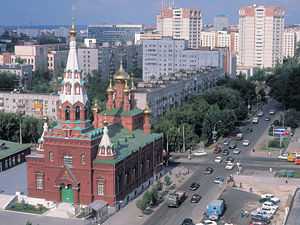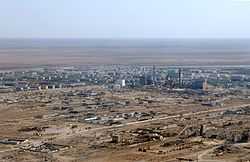Closed city

A closed city or closed town is a settlement where travel and/or residency restrictions are applied so that specific authorization is required to visit or remain overnight.
They may be sensitive military establishments or secret research installations which require much more space or freedom than is available in a conventional military base. There may also be a wider variety of permanent residents including close family members of workers and/or trusted traders who are not directly connected with its obscured purposes.
Closed cities are a feature of heavily militarized countries and secretive regimes, and many still exist in the successor countries to the Soviet Union. In modern Russia, such places are officially known as "closed administrative-territorial formations" (закрытые административно-территориальные образования, zakrytye administrativno-territorial'nye obrazovaniya, or ЗАТО ZATO for short).
Structure and operations

Sometimes closed cities may only be represented on classified maps which are not available to the general public. In some cases there may be no road signs or directions to closed cities, and they are usually omitted from railroad time tables and bus routes.
Sometimes closed cities may be indicated obliquely as a nearby insignificant village, with the name of the stop serving the closed city made equivocal or misleading. For mail delivery, a closed city is usually named as the nearest large city and a special postcode e.g. Arzamas‑16, Chelyabinsk‑65. The actual settlement can be rather distant from their namesakes, for instance, Sarov, designated Arzamas-16, is in the federal republic of Mordovia, whereas Arzamas is in the Nizny Novgorod region (roughly 75 kilometres (47 mi) away). People not dwelling in a closed city were subject to document checks and security checkpoints, and explicit permission was required for them to visit.[1] To relocate to the closed city, one would need security clearance by the KGB.
The closed city was sometimes guarded by a security perimeter with barbed wire and towers, much like a prison. This did not limit the freedom of the residents, who could easily cross the perimeter via the security checkpoint. The very fact of such a city's existence was often classified, and residents were expected not to divulge to outsiders their place of residence. This lack of freedom was often compensated by better housing conditions and a better choice of goods in retail trade than elsewhere in the country. Also, in the USSR, people working with classified information received a salary bonus.
The "box"
The "box" was the unofficial name of a secret Soviet facility much like the closed city, but smaller, usually the size of a factory. The "box" name was usually classified, as were the activities there. Incoming mail was addressed to "mailbox #XXXX", thus the name of "box". Most Soviet design bureaus for weapons, aircraft, space, military electronics, etc. were "boxes".
Soviet closed cities

Closed cities were established from the late 1940s onwards under the euphemistic name of "post boxes", referring to the practice of addressing post to them via mail boxes in other cities. They fell into two distinct categories.
- The first category comprised relatively small communities with sensitive military, industrial, or scientific facilities, such as arms plants or nuclear research sites.[2] Examples are the modern towns of Ozyorsk (Chelyabinsk-65) with a plutonium production plant, and Sillamäe, the site of a uranium enrichment facility. Even Soviet citizens were not allowed access to these places without proper authorization. In addition to this, some bigger cities were closed for unauthorized access to foreigners, while they were freely accessible to Soviet citizens. These included cities like Perm, a center for Soviet tank production, and Vladivostok, the base of the Soviet Pacific Fleet.
- The second category consisted of border cities (and some whole border areas, such as the Kaliningrad Oblast, Saaremaa, and Hiiumaa) which were closed for security purposes. Comparable closed areas existed elsewhere in the East bloc; a substantial area along the inner German border and the border between West Germany and Czechoslovakia was placed under similar restrictions (although by the 1970s foreigners could cross the latter by train). Citizens were required to have special permits to enter such areas.
The locations of the first category of the closed cities were chosen for their geographical characteristics. They were often established in remote places situated deep in the Urals and Siberia, out of reach of enemy bombers. They were built close to rivers and lakes which were used to provide the large amounts of water needed for heavy industry and nuclear technology. Existing civilian settlements in the vicinity were often used as sources of construction labour. Although the closure of cities originated as a strictly temporary measure which was to be normalized under more favorable conditions, in practice the closed cities took on a life of their own and became a notable institutional feature of the Soviet system.[3]
Movement to and from closed areas was tightly controlled. Foreigners were prohibited from entering them and local citizens were under stringent restrictions. They had to have special permission to travel there or leave, and anyone seeking residency was required to undergo vetting by the NKVD and its successor agencies. Access to some closed cities was physically enforced by surrounding them with barbed wire fences monitored by armed guards.
After over 20 years since the end of the Soviet Union, Russia officially still keeps a great number of its closed cities in the former Soviet republics: Belarus, Kazakhstan, Uzbekistan, Kyrgyzstan, Tajikistan, Moldova (Transnistria), Azerbaijan, and Armenia.
Closed cities of the former Soviet Union

The policy of closing cities underwent major changes in the late 1980s and early 1990s. Some cities, such as Perm, were opened well before the fall of the Soviet Union; others, such as Kaliningrad and Vladivostok, remained closed until as late as 1992. The adoption of a new constitution for the Russian Federation in 1993 prompted significant reforms to the status of closed cities, which were renamed "closed administrative-territorial formations" (or ZATO, after the Russian acronym). Municipally all such entities have a status of urban okrugs, as mandated by the federal law.
Russia
There are currently 44 publicly acknowledged closed cities in Russia with a total population of about 1.5 million people. 75% are administered by the Russian Ministry of Defense, with the rest being administered by the Russian Federal Atomic Energy Agency, formerly the Ministry for Atomic Energy (Minatom).[4] Another 15 or so closed cities are believed to exist, but their names and locations have not been publicly disclosed by the Russian government.[5]
The number of closed cities in Russia is defined by government decree (see links further). They include the following cities (reason for restriction in parentheses):
- Amur Oblast: Uglegorsk (site of the 2nd Russian trial cosmodrome of the Ministry of Defense of the Russian Federation, also called Svobodny Cosmodrome)
- Arkhangelsk Oblast: Mirny (site of Plesetsk Cosmodrome)
- Astrakhan Oblast: Znamensk (Kapustin Yar rocket launch site)
- Republic of Bashkortostan: Mezhgorye (129th Directorate of strategic subjects' technical supply and maintenance)
- Chelyabinsk Oblast: Ozyorsk (nuclear waste processing and recycling plant), Snezhinsk (site of one of the two major Russian Federal Nuclear Centers), Tryokhgorny (development of parts and machinery for atomic stations and weaponry)
- Kamchatka Krai: Vilyuchinsk
- Krasnoyarsk Krai: Zelenogorsk, Norilsk, Zheleznogorsk, Dikson
- Leningrad Oblast: Sosnovy Bor
- Moscow Oblast: Krasnoznamensk, Zvyozdny gorodok, Vlasikha
- Murmansk Oblast: Alexandrovsk, Ostrovnoy, Severomorsk, Zaozyorsk
- Nizhny Novgorod Oblast: Sarov
- Penza Oblast: Zarechny
- Primorsky Krai: Bolshoy Kamen, Fokino
- Saratov Oblast: Shikhany
- Sverdlovsk Oblast: Lesnoy, Novouralsk, Svobodny
- Tomsk Oblast: Seversk
- Vladimir Oblast: Raduzhny
Some of them are open for foreign investment, but foreigners may only enter with a permit. An example is the Nuclear Cities Initiative (NCI), a joint effort of the United States National Nuclear Security Administration and Minatom, which involves in part the cities of Sarov, Snezhinsk, and Zheleznogorsk.
The number of closed cities has been significantly reduced since the mid-1990s. However, on 30 October 2001, foreign travel (without any exceptions) was restricted in the northern cities of Norilsk, Talnakh, Kayerkan, Dudinka, and Igarka. Russian citizens visiting these cities are not required to have travel permits.
Krasnoyarsk-26 in Siberia, researched for the subject of Sidney Sheldon's 2001 fictional murder mystery-romance The Sky is Falling,[6] was planned in 2003 to be shut down by 2011,[7] in co-operation with the U.S, and documented by their Natural Resources Defense Council,[8] but actually closed in 2008.[9]
Kazakhstan

Three closed cities under Russian administration exist in Kazakhstan:
- Baikonur (formerly Leninsk), a city constructed to service the Baikonur Cosmodrome
- Kurchatov township at the Semipalatinsk Test Site
- Priozersk, the administrative center of the Sary Shagan anti-ballistic missile testing site
Ukraine
Ukraine had eighteen closed cities: among them the Crimean port of Sevastopol and the industrial city of Dnipropetrovsk, though both were restricted to foreigners, not locals. Travel restrictions were lifted in the mid-1990s.. Crimea has since been annexed by Russia (internationally unrecognized).
Moldova
Moldova has one official closed city — the commune Cobasna (Rîbnița District) in the disputed area of Transnistria. The commune, located on the left bank of the Dniester river, still contains military warehouses of the former Soviet 14th Army.
Estonia
There were two closed cities in Estonia: Sillamäe and Paldiski. As with all the other industrial cities, the population of them was mainly Russian-speaking. Sillamäe was the site for a chemical factory that produced fuel rods and nuclear materials for the Soviet nuclear power plants and nuclear weapon facilities, while Paldiski was home to a Soviet Navy nuclear submarine training centre. Sillamäe was closed until Estonia regained its independence in 1991; Paldiski remained closed until 1994, when the last Russian warship left.
Tartu, home to Raadi Airbase, was partially closed. Foreign academics could visit the University of Tartu, but had to sleep elsewhere.
Closed cities of the United States
- Oak Ridge, Tennessee, was a closed city during the Manhattan Project
- Los Alamos, New Mexico, was a closed city during the Manhattan Project
- Mercury, Nevada, is currently closed as part of a test site
See also
- Company town
- Gated community
- Internal passport
- List of closed cities
- Mercury, Nevada
- Naukograd
- Nuclear Cities Initiative
- Propiska
- Propiska in the Soviet Union
- Los Alamos, New Mexico
References
- ↑ "City border". Photoarchives. FOTOESCAPE. Retrieved 2013-03-16.
- ↑ "Secret Cities". GlobalSecurity.org. Accessed August 2011.
- ↑ Victor Zaslavsky, "Ethnic group divided: social stratification and nationality policy in the Soviet Union", p. 224, in Peter Joseph Potichnyj, The Soviet Union: Party and Society, Cambridge University Press, 1988. ISBN 0-521-34460-3.
- ↑ Nadezhda Kutepova & Olga Tsepilova, "A short history of the ZATO", pp. 148–149, in Cultures of Contamination, Volume 14: Legacies of Pollution in Russia and the US (Research in Social Problems and Public Policy), editors Michael Edelstein, Maria Tysiachniouk, Lyudmila V. Smirnova. JAI Press, 2007. ISBN 0-7623-1371-4
- ↑ Greg Kaser, "Motivation and Redirection: Rationale and Achievements in the Russian Closed Nuclear Cities", p. 3, in Countering Nuclear and Radiological Terrorism, editors David J. Diamond, Samuel Apikyan, Greg Kaser. Springer, 2006. ISBN 1-4020-4897-1
- ↑ ISBN 0446610178, "The Sky is Falling", by Sidney Sheldon, 2001
- ↑ John Pike. "Krasnoyarsk-26". Retrieved 14 January 2015.
- ↑ http://docs.nrdc.org/nuclear/files/nuc_01019501a_138.pdf
- ↑ "Russia closes Soviet-era weapons grade reactor". Reuters. Retrieved 14 January 2015.
Further reading
- Sneider, Daniel (February 4, 1992). "Visit to 'Closed' City Brings Quick Celebrity". The Christian Science Monitor. Retrieved 13 January 2015.
External links
- (Russian) Current list of (acknowledged) closed cities / areas, from the Russian Federation Administration website.
- Russia's closed cities are open and shut case – article from Russia Journal. (Original source requires paid subscription .)
- National Nuclear Security Administration, U.S. Deptartment of Energy website.
- "Secret Cities" (article), from www.globalsecurity.org.
- Secret / Closed cities in Google Earth.
- Right to the city in former Soviet Union closed cities (ZATO). Andrius Ropolas's paper focusing upon the social aspects of closed cites. Helpful bibliography.
| ||||||||
